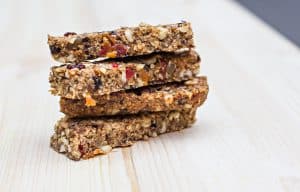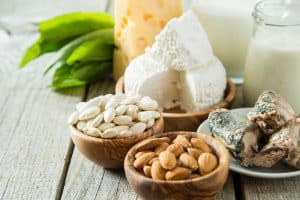The US Dietary Guidelines identify fiber as a nutrient of concern because most Americans do not consume the recommended dietary fiber intake is 14g/1,000 kcal which is estimated to be a daily intake of 25g (female) or 38g (male). While a high-fiber diet is often defined as a diet that includes > 25 grams of fiber per day, the diet should be considered high relative to current intake. High fiber diets are recommended for the general population rather than being a diet pattern for individuals with specific health conditions. This is because it is well known that consumption of the recommended amount of dietary fiber helps to maintain health and wellness. Fibers have numerous health benefits, more and more are being discovered every day. While many consumers are familiar with the role of fiber in promoting gastrointestinal health and regularity there are a number of other health benefits that are worthy of discussion with patients.
Benefits of High Fiber
Most Americans do not consume the recommended dietary fiber intake

In particular, the specific benefits of dietary fibers include:
- References
Coxam V. Current data with inulin-type fructans and calcium, targeting bone health in adults. J Nutr. 2007 Nov;137(11 Suppl):2527S-2533S.
den Besten G, van Eunen K, Groen AK, Venema K, Reijngoud DJ, Bakker BM. The role of short-chain fatty acids in the interplay between diet, gut microbiota, and host energy metabolism. J Lipid Res. 2013 Sep;54(9):2325-40. doi: 10.1194/jlr.R036012.
McRorie JW Jr, McKeown NM. Understanding the Physics of Functional Fibers in the Gastrointestinal Tract: An Evidence-Based Approach to Resolving Enduring Misconceptions about Insoluble and Soluble Fiber. J Acad Nutr Diet. 2017 Feb;117(2):251-264. doi: 10.1016/j.jand.2016.09.021.
Slavin J. Fiber and prebiotics: mechanisms and health benefits. Nutrients. 2013 Apr 22;5(4):1417-35. doi: 10.3390/nu5041417.
Bindels LB, Segura Munoz RR, Gomes-Neto JC, Mutemberezi V, Martínez I, Salazar N, Cody EA, Quintero-Villegas MI, Kittana H, de Los Reyes-Gavilán CG, Schmaltz RJ, Muccioli GG, Walter J, Ramer-Tait AE. Resistant starch can improve insulin sensitivity independently of the gut microbiota. Microbiome. 2017 Feb 7;5(1):12. doi: 10.1186/s40168-017-0230-5.
Canfora EE, Blaak EE. The role of polydextrose in body weight control and glucose regulation. Curr Opin Clin Nutr Metab Care. 2015 Jul;18(4):395-400. doi: 10.1097/MCO.0000000000000184.
Keenan MJ, Zhou J, Hegsted M, Pelkman C, Durham HA, Coulon DB, Martin RJ. Role of resistant starch in improving gut health, adiposity, and insulin resistance. Adv Nutr. 2015 Mar 13;6(2):198-205. doi: 10.3945/an.114.007419.
- Improved Digestive Health and Short-Chain Fatty Acid Production
 It is well known that dietary fiber promotes a healthy digestive tract. Some types of fibers provide bulking and help with regularity. Fermentable fibers may be more important than bulking fibers for colonic health because the short-chain fatty acids (SCFAs) produced by the fermentation actively facilitate digestive health. In particular, butyrate and propionate, two primary SCFAs produced by the fermentation of dietary fibers, are vital for health and well-being, as they optimize motor activity of the colon, help to regulate physiological intestinal mobility, and contribute to the defense mechanisms of the intestinal barriers. In addition, butyrate is the primary and preferred fuel for colon cells. Emerging evidence suggests that SCFAs may contribute anti-inflammation and anti-cancer benefits as well.
It is well known that dietary fiber promotes a healthy digestive tract. Some types of fibers provide bulking and help with regularity. Fermentable fibers may be more important than bulking fibers for colonic health because the short-chain fatty acids (SCFAs) produced by the fermentation actively facilitate digestive health. In particular, butyrate and propionate, two primary SCFAs produced by the fermentation of dietary fibers, are vital for health and well-being, as they optimize motor activity of the colon, help to regulate physiological intestinal mobility, and contribute to the defense mechanisms of the intestinal barriers. In addition, butyrate is the primary and preferred fuel for colon cells. Emerging evidence suggests that SCFAs may contribute anti-inflammation and anti-cancer benefits as well. - Reduced Constipation

Dietary fiber, including fiber added to foods, can help reduce constipation by adding bulk to the stool. Bulky feces move through the gut faster, resulting in an increased stool weight and improved regularity. Stool consistency, stool weight and frequency of defecation are indicators of colonic function. Increased bulking and decreased transit time are considered as the most widely known beneficial effects of dietary fibers in general. Different kinds of dietary fiber can have different bulking capacities, depending on the underlying mechanism. Poorly fermented fibers add bulk and, in some cases, add bulk by increasing water binding. Fermentable dietary fibers provide a bulking effect mainly due to increased bacterial mass.
- Improved Regularity
 Regularity can be defined as the regular (eg, daily) elimination of bulky/soft/easy-to-pass stools and can be assessed by determining both stool output (assessed as grams of stool per day or per week) and stool water content (%). Insoluble fiber can improve regularity by stimulating the large bowel to increase secretion of water and mucous while soluble gel-forming fibers increase the water-holding capacity of stool. Both fibers increase stool water content and result in bulky/soft stools that are easy to pass.
Regularity can be defined as the regular (eg, daily) elimination of bulky/soft/easy-to-pass stools and can be assessed by determining both stool output (assessed as grams of stool per day or per week) and stool water content (%). Insoluble fiber can improve regularity by stimulating the large bowel to increase secretion of water and mucous while soluble gel-forming fibers increase the water-holding capacity of stool. Both fibers increase stool water content and result in bulky/soft stools that are easy to pass.While consuming the recommended daily intake of fiber is associated with numerous health benefits, no single fiber provides all benefits. A variety of fibers are needed every day for the body to function well.
- Reduced Cholesterol Levels
 Studies have linked a high-fiber diet with improvements in serum lipids, total cholesterol, low-density lipoprotein cholesterol (LDL-C), high-density lipoprotein cholesterol (HDL-C), and triglycerides. Epidemiological studies have found reduced rates of coronary heart disease in individuals consuming high amounts of dietary fiber. Importantly, clinical studies have shown that certain types of viscous fibers (i.e., beta-glucan, psyllium, guar gum) reduce the absorption of cholesterol. The mechanism of action for this benefit is the increased viscosity of gel-forming fibers that trap bile and its cholesterol component. The trapped bile is then eliminated in stool.
Studies have linked a high-fiber diet with improvements in serum lipids, total cholesterol, low-density lipoprotein cholesterol (LDL-C), high-density lipoprotein cholesterol (HDL-C), and triglycerides. Epidemiological studies have found reduced rates of coronary heart disease in individuals consuming high amounts of dietary fiber. Importantly, clinical studies have shown that certain types of viscous fibers (i.e., beta-glucan, psyllium, guar gum) reduce the absorption of cholesterol. The mechanism of action for this benefit is the increased viscosity of gel-forming fibers that trap bile and its cholesterol component. The trapped bile is then eliminated in stool. - Reduced Blood Glucose Levels

For over 30 years, studies have shown the viscosity of a fiber is related to the reduction in postprandial blood glucose. Reduced post-prandial blood glucose levels are considered one of the traditional beneficial physiological effects related to viscous fibers. Viscous, gel-forming fibers (i.e., psyllium and guar gum) slows the absorption of glucose of glucose and other nutrients at the intestinal brush border and can thus lower the glycemic impact of foods (causing a lower rise in blood glucose levels). Unlike foods comprised of rapidly digested and absorbed carbohydrates, foods containing viscous fibers are associated with a slower rise in blood glucose and a lower blood glucose peaks. Additionally, fibers can lower the glycemic impact of foods when substituted for high-glycemic flours and sugars in food formulations. Studies have also shown that these gel-forming fibers can improve reduced fasting blood glucose, insulin, and glycated hemoglobin (hemoglobin A1c, HbA1c) in individuals that are at risk for developing type 2 diabetes or being treated for type 2 diabetes.
- Increased Insulin Sensitivity

Resistant starch from foods as well as isolated from high amylose corn has been shown to increase insulin sensitivity. Researchers are suggesting that fermentation in the large intestine may be contributing to this benefit, as the short-chain fatty acids (SCFAs) produced by the fermentation of certain fibers triggers the production of hormones related to insulin sensitivity and elicits shifts in metabolism within the intestinal tract by up-regulating the production of hormones important to lipid and carbohydrate metabolism.
- Increased Mineral Absorption
 Fermentable fiber sources may improve the absorption of minerals, especially calcium. Clinical studies have demonstrated improved calcium absorption and improvements in bone mineral density in adolescents who had consumed short-chain, long-chain inulin-type fructans, and some fermentable dietary fibers, such as soluble corn fiber. There are several potential mechanisms to explain the favorable effect of prebiotic oligosaccharides fibers on mineral absorption: (1) fermentation lowers the intestinal pH, which increases the solubility of the minerals, enhancing passive absorption within the large intestine, and (2) fermentable fibers may enhance the absorptive capacity of the cells within the intestinal tract for minerals, either by increasing the absorptive area or by increasing the active transporter pathways. Traditionally, the large intestine was not generally associated with calcium absorption but there is increasing evidence that the human colon can absorb nutritionally significant amounts of calcium.
Fermentable fiber sources may improve the absorption of minerals, especially calcium. Clinical studies have demonstrated improved calcium absorption and improvements in bone mineral density in adolescents who had consumed short-chain, long-chain inulin-type fructans, and some fermentable dietary fibers, such as soluble corn fiber. There are several potential mechanisms to explain the favorable effect of prebiotic oligosaccharides fibers on mineral absorption: (1) fermentation lowers the intestinal pH, which increases the solubility of the minerals, enhancing passive absorption within the large intestine, and (2) fermentable fibers may enhance the absorptive capacity of the cells within the intestinal tract for minerals, either by increasing the absorptive area or by increasing the active transporter pathways. Traditionally, the large intestine was not generally associated with calcium absorption but there is increasing evidence that the human colon can absorb nutritionally significant amounts of calcium. - Increased Immune Support

Specific fermentable fibers have been shown to provide support for healthy immune function. Two mechanisms contribute to this benefit: increased levels of beneficial bacteria (i.e., Bifidobacteria, Lactobacillus) and reduced adhesion of pathogens to the colonic cell walls, which aids in flushing them from the digestive tract. Prebiotic oligosaccharides have also been utilized in infant formula to imitate the beneficial effects of breast milk for newborn infants and young children. It has been shown that human milk oligosaccharides have a significant impact on the initial bacterial colonization within the newborn baby’s intestinal tract. The microbiota facilitates proper digestion and may provide stimulation and balance for the immune system. Recent research has shown that infant formula fortified with prebiotic oligosaccharides can improve immune function. Thus, establishing a healthy balance of microbiota early in life may contribute to long-term health outcomes, because early colonizing microbiota have stronger adhesion and persistence within the intestinal tract than prebiotic bacteria consumed later in life.
- Weight Management
 Dietary fiber may contribute to maintaining a healthy weight. Epidemiological studies have consistently show that obese adults consume less dietary fiber than their lean counterparts. There is significant research investigating the weight management benefits of specific dietary fibers. Potential mechanisms include slowing gastric emptying and small bowel transit via the ileal brake to reduce both hunger and food intake and fermentation of the dietary fibers increasing the production of short-chain fatty acids that increase the production of hormones important to lipid and carbohydrate metabolism. It is clear, however, that different fibers have different effects and may impact weight via different mechanisms.
Dietary fiber may contribute to maintaining a healthy weight. Epidemiological studies have consistently show that obese adults consume less dietary fiber than their lean counterparts. There is significant research investigating the weight management benefits of specific dietary fibers. Potential mechanisms include slowing gastric emptying and small bowel transit via the ileal brake to reduce both hunger and food intake and fermentation of the dietary fibers increasing the production of short-chain fatty acids that increase the production of hormones important to lipid and carbohydrate metabolism. It is clear, however, that different fibers have different effects and may impact weight via different mechanisms.

